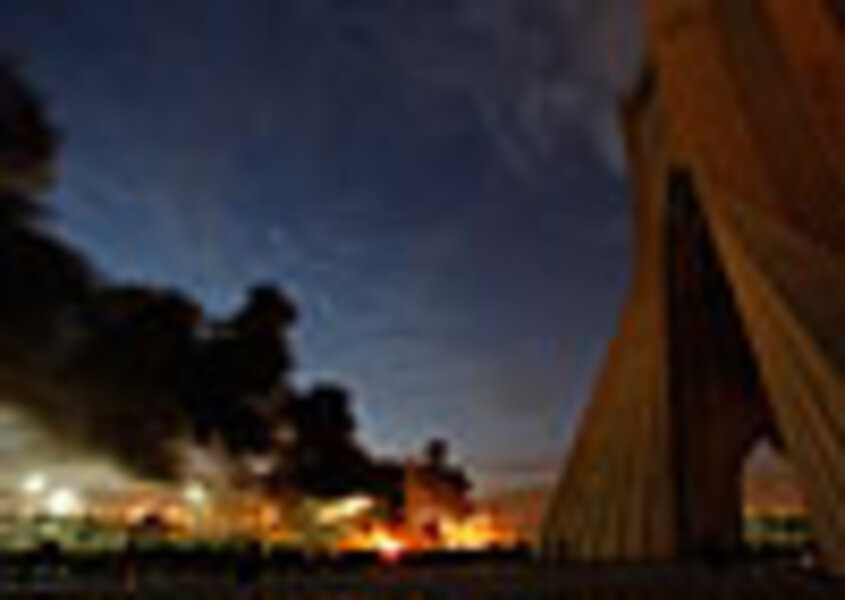Eyewitness: Iranian militiamen shot 300 rounds during Monday's protest
Loading...
| Istanbul, Turkey
Amid scenes reminiscent of the street turbulence that led to Iran's 1979 Islamic revolution, the country's powerful Guardian Council said on Tuesday it is willing to conduct a partial recount of the contested presidential election after eight were killed in a massive protest Monday.
Even state television announced the death toll at the protest, in which hundreds of thousands rallied in support of defeated candidate Mir Hossein Mousavi, claiming widespread fraud led to President Ahmadinejad's victory. The state TV anchor said that organized "wicked people" had "attacked and caused massive destruction," resulting in the deaths.
An Iranian journalist who witnessed the shooting told the Monitor that, in fact, the gunmen were plainclothed basiji militia in riot helmets and body armor who fired an estimated 300 bullets from a rooftop – roughly half into the air, and the other half directly into the crowd, over the course of an hour.
"The guy shooting from the roof was very calm, not like he was shooting at people," said the witness. The ideological militiamen, who operate under the auspices of the Revolutionary Guards, fired as if "they were just trying to empty their guns into the ground, very cool, very relaxed."
The resulting images of protesters with green armbands carrying away their dead comrades – with looks of horror on their faces and shouts for help on their lips – evoked the prolonged bloody protests that shook Iran before the 1979 revolution.
Back then, soldiers of the pro-West shah fired directly on student protesters, prompting a growing cycle of violent 40-day mourning protests, which produced yet more dead "martyrs" each round and eventually led to the fall of the government.
The government on Tuesday announced sweeping restrictions on foreign journalists, ordering that no rallies were to be reported upon without official approval. Since the vote, intelligence agents have been in Iranian newsrooms, supervising.
The regime's bid Tuesday to calm violence with the promise of a partial recount is "too little, too late," political science professor Sadiq Zibakalam told Al Jazeera-English television from Tehran.
"Nothing short of declaring the election result null and void would actually stop the protest of the people," said Professor Zibakalem of Tehran University.
"The government is thinking all the time: 'If I stand tough, if I react violently, it will stop people from demonstrating,'" he added. "What the government doesn't realize is that to react severely and try to suppress the people, it will only intensify people's anger."
Protesters' target: Ahmadinejad, not Islamic system
In Tehran on Tuesday, rival rallies were slated as supporters of the defeated Mir Hossein Mousavi – who believe their candidate was robbed of victory by widespread fraud – tried to capitalize on momentum from the vast gathering on Monday of hundreds of thousands that stretched from Revolution Square to Freedom Square in Tehran.
In a bid to avoid violence and "protect lives," Mr. Mousavi called on his followers not to gather at the same place as on Monday, but at points some miles away in north Tehran.
Rallygoers on Monday said their goal was to remove President Mahmoud Ahmadinejad, who was declared the winner of the June 12 vote in an unexpected 2-to-1 landslide. They do not aim to overthrow the Islamic system headed by Iran's supreme religious leader, Ayatollah Sayed Ali Khamenei, a system that Mousavi has supported since the first years of the revolution when he was prime minister.
Events in the four days since the election results were announced amount to the greatest street violence in the past decade, and the greatest rally – on Monday – since the era of the revolution.
Pro-Mousavi Iranians have battled security forces and pro-government vigilantes daily, burning cars and motorcycles, blocking roads with burning barricades and throwing stones.
During 'silent' march, militiamen fire into crowd
Even if the target was not the Islamic system, called the nezam, the anger and the imagery of the protests would not have been lost on Iran's aging revolutionaries – nor on the possibly explosive consequences.
"They shot three people in front of my eyes [on Monday], while everything was going quietly and nicely," the witness told the Monitor. Despite the large numbers at the rally, it was a "silent" event in which there were deliberately few provocative chants.
The witness said another building that served as a basiji base along the route had been surrounded by a human chain and had been presented with flowers. At the basiji base that was attacked, newswire photographs showed a militiaman throwing a stone at protesters over the fence – an act that may have provoked the crowd to attack the building. The building caught on fire and gunmen began shooting from the roof.
"Instead of tear gas, [they] started shooting in the air," said the witness. "That further agitated the people and they kept storming the building. Then they pointed without aiming [holding the assault rifles at hip level] and started to shoot."
Antiriot police wearing body armor and riding motorcycles came to rescue the basiji militiamen, but were knocked from their bikes by the crowd and beaten.
This witness was angry over the bloodshed, and he says he was not alone. "The taste in my mouth changed. I could not believe that they would be as stupid to do this," said the witness. "I felt angry. I felt that this was it. Blood cannot be ignored."
The Guardian Council recount "will have the same result; they are not going to unseat their own puppet," said the witness, who said more violence and possibly civil war could come about as a result. "I think all chances of going back have been lost. People won't back off."





